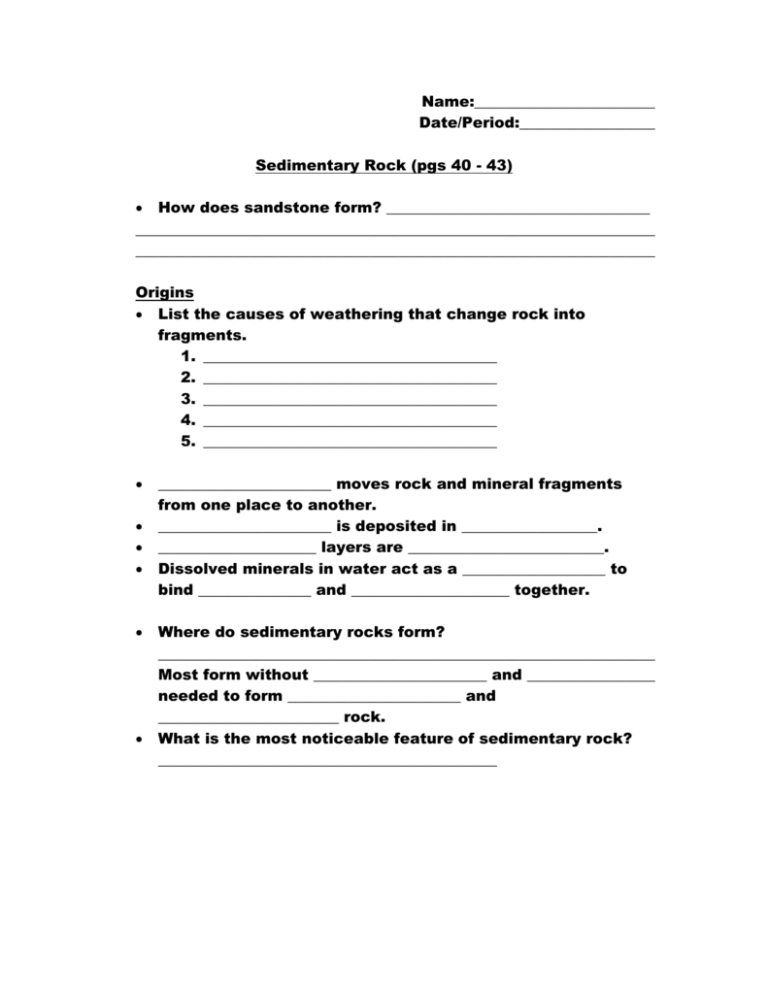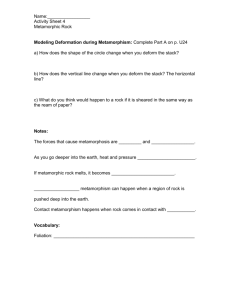Sedimentary Rock (pgs 40
advertisement

Name:________________________ Date/Period:__________________ Sedimentary Rock (pgs 40 - 43) How does sandstone form? ___________________________________ _____________________________________________________________________ _____________________________________________________________________ Origins List the causes of weathering that change rock into fragments. 1. _______________________________________ 2. _______________________________________ 3. _______________________________________ 4. _______________________________________ 5. _______________________________________ _______________________ moves rock and mineral fragments from one place to another. _______________________ is deposited in __________________. _____________________ layers are __________________________. Dissolved minerals in water act as a ___________________ to bind _______________ and _____________________ together. Where do sedimentary rocks form? __________________________________________________________________ Most form without _______________________ and _________________ needed to form _______________________ and ________________________ rock. What is the most noticeable feature of sedimentary rock? _____________________________________________ Composition and Classification: 1. Clastic – forms when _________________ or ________________ fragments are ____________________ together. Figure 2 page 41 Mineral Cement = _________________ and _________________. Classified by ________________ of _________________________. 2. Chemical – forms when _____________________ ___________________ out of a solution such as sea water. ____________________ dissolves rock material as it passes through. Some dissolve material eventually crystallizes. An example: ______________________________. 3. Organic – form from _____________________________________ _______________________________________________________________ Figure 4 (page 42) Limestone formed from _________________________________ _______________________________________________________________ Coal forms ___________________________ from _________________________ ___________________ ________________________ buried beneath sediment, changed over millions of years by heat and pressure. Stratification: ________________________________________________________________________ ________________________________________________________________________ Metamorphic Rock (pgs 44 - 49) Metamorphic means ___________________________. What changes when metamorphic rock forms? _________________________ _________________________ _________________________ Origins: What conditions are needed for a rock to undergo metamorphism? _______________________________________________ ____________________________________________________________________ It is the ________________________ and ______________________ at which metamorphic rocks form that allows rock to heat to a very high temperature. __________________ ______________________ within Earth’s _____________ cause ______________________ _____________________ to be exerted on the rock. 1. Contact Metamorphic Rock Rock undergoes metamorphism by ______________________________________________________ The greatest change takes place where ______________________________________________________ Occurs near igneous rock formations. 2. Regional Metamorphic Rock Formed when _________________________ builds up deep below other rock formations. Or when _________________ __________________ of Earth’s crust ___________________. _________________________ boundary. Compostion: When __________________________ and _______________________ change, the original __________________ change into new _______________________. Figure 3 (page 46) _____________ + _____________ + _____________ + Heat = __________ and pressure Figure 4 (page 46) Scientists can understand a metamorphics rocks history by observing its mineral content. Example: Metamorphic rock that contains ________________ formed at a __________________ depth and under greater ____________ and __________________ than a rock that contains ___________________. Texture: 1. Foliated - __________________ grains are arranged in ________________. Figure 5 – The effects of metamorphism depend on the heat and pressure applied to the rock. Sedimentary shale can become the following as more heat and pressure are applied. 1. _______________________ 2. _______________________ 3. _______________________ 4. _______________________ 2. Nonfoliated – mineral grains are not arranged in bands. Commonly made of _______________ or a _____________ minerals. Figure 6 - Sedimentary rocks that recrystallize. ________________ _____________________ reforms into quartzite, where the mineral _________________ have grown larger. When ______________________ undergoes metamorphism, ______________ crystals become larger and form _______________________.







